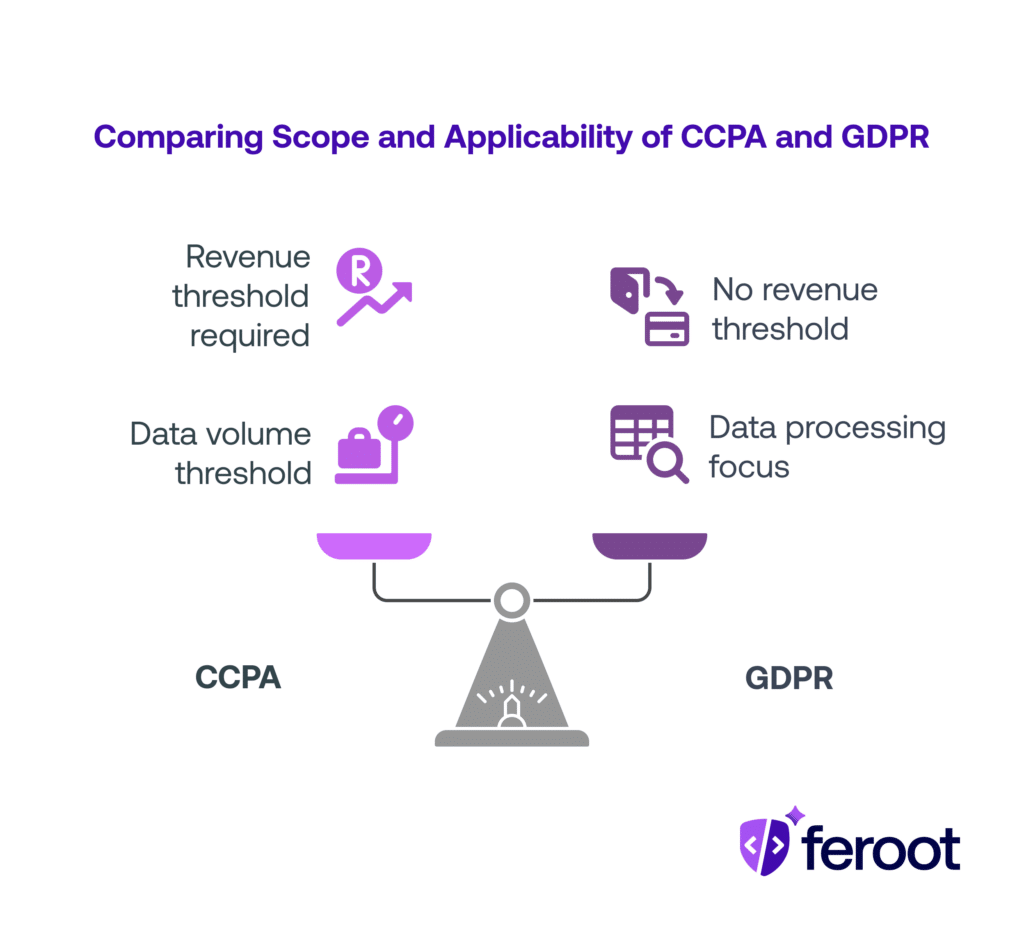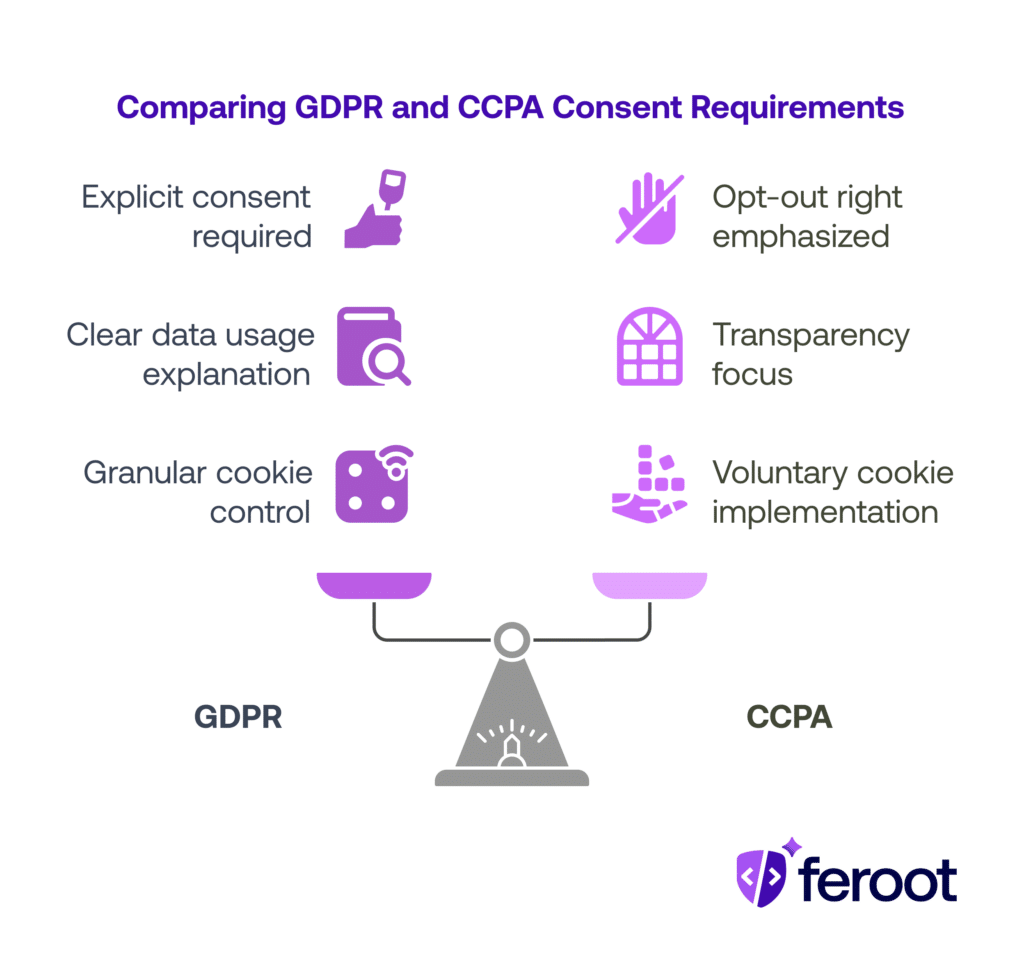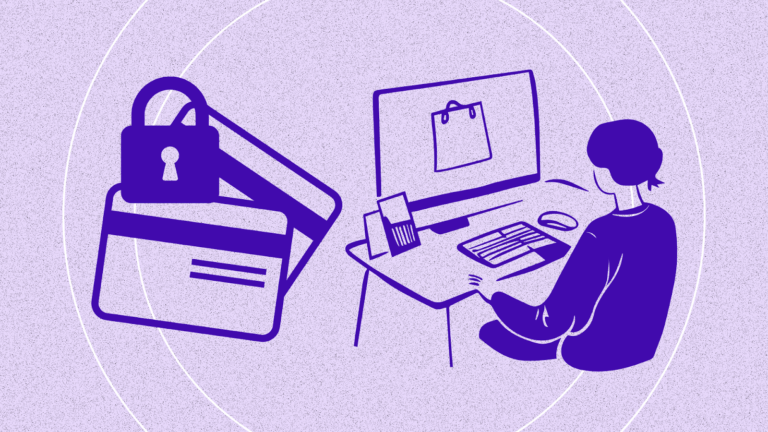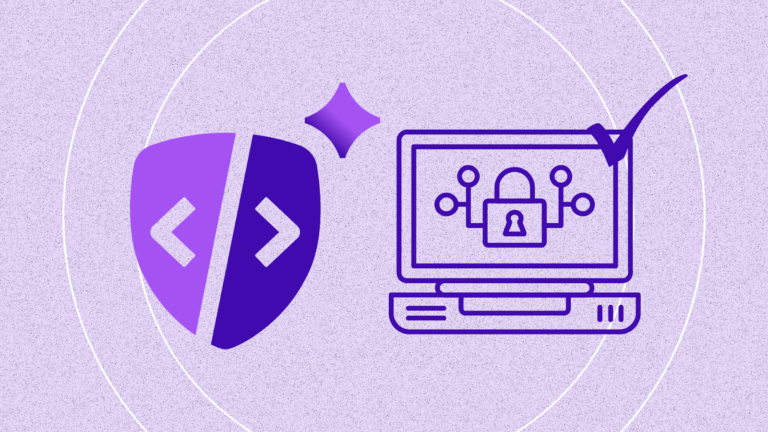Introduction
The digital privacy landscape is defined largely by two leading regulatory frameworks: the California Consumer Privacy Act (CCPA) and the European Union’s General Data Protection Regulation (GDPR). For businesses with online operations, understanding how the CCPA and GDPR differ is more than just a legal necessity—it’s a strategic imperative. Each regulation sets expectations for transparency, consent, and data rights, but they do so in ways that can vary significantly across jurisdictions.
In this article, we’ll break down the core differences between CCPA and GDPR, helping you stay compliant and reduce risk while building user trust.
What are the CCPA and GDPR?
CCPA is California’s landmark data privacy law that gives residents rights over how their personal information is collected, used, and sold by businesses. It became enforceable in 2020 and applies to for-profit companies that meet specific thresholds.
GDPR, which came into force in 2018, is the European Union’s comprehensive data protection regulation. It governs the processing of personal data of individuals in the EU and applies to organizations worldwide that handle this data.
In short:
- CCPA is region-specific (California), but its influence extends to any business that targets California consumers.
- GDPR has global applicability if EU residents’ data is involved—regardless of where the company is based.
Differences in Scope and Applicability
CCPA applies to businesses that meet at least one of the following:
- Generate over $25 million in annual revenue
- Handle data of 100,000+ consumers, households, or devices
- Derive 50%+ of revenue from selling or sharing personal information
GDPR applies to:
- Any organization (regardless of revenue) that collects or processes personal data of individuals in the EU/EEA
- Both for-profit and nonprofit entities
Unlike CCPA, GDPR does not require a business to meet revenue or volume thresholds to fall under its scope—it focuses on the nature and intent of data processing activities.

Comparing User Rights
The CCPA and GDPR both provide individuals with critical rights over their personal data, but the depth, enforcement, and practical impact of these rights vary across the two frameworks. Below is a side-by-side breakdown of the key user rights under each regulation:
User Rights Under CCPA:
- Right to Know: California residents have the right to know what personal information a business has collected about them, including the categories of data, the sources of that data, the business purposes for collection, and the third parties with whom it is shared. This provision is central to the CCPA’s transparency goals and allows users to make informed decisions about their digital footprint.
- Right to Delete: Users can request that a business delete the personal information it has collected about them. However, there are several exceptions—for example, if the data is needed to complete a transaction, detect security incidents, or comply with a legal obligation. Even with exceptions, this right helps users reduce their long-term data exposure.
- Right to Opt Out of Sale or Sharing: One of the hallmark features of the CCPA is the user’s ability to opt out of the sale or sharing of their personal data. Businesses must include a clearly visible link titled “Do Not Sell or Share My Personal Information” on their websites. This right aims to give users greater control over how their data is monetized by third parties.
- Right to Correct: Introduced through the CPRA (which amends the CCPA), this right allows consumers to request that businesses correct inaccurate personal information. It’s especially important for data used in identity verification, customer profiling, and financial decisions.
- Right to Limit Use of Sensitive Information: Also introduced by the CPRA, this right enables users to restrict how sensitive data—such as health records, precise geolocation, and race or ethnicity—is used. Businesses must honor these preferences unless the data use is essential for service delivery.
- Right to Data Portability: Users can request a copy of their personal information in a structured, commonly used, and machine-readable format. This facilitates data migration and gives consumers more freedom to switch service providers while retaining control over their personal data.
User Rights Under GDPR:
- Right to Access: GDPR grants individuals the right to confirm whether an organization is processing their personal data and, if so, to receive a detailed explanation of how that data is being used. This includes information about the purpose of processing, categories of data, recipients, storage duration, and legal basis. It empowers users to hold businesses accountable.
- Right to Rectification: Users have the right to request the correction of inaccurate or incomplete personal data without undue delay. This is critical for maintaining the accuracy of information used in decision-making systems such as credit scoring, insurance underwriting, and job applications.
- Right to Erasure (Right to Be Forgotten): Individuals may request the deletion of their personal data when it is no longer necessary for its original purpose, when consent is withdrawn, or when processing is unlawful. While subject to exceptions (e.g., freedom of expression, public interest), this right gives users powerful control over long-term data retention.
- Right to Object: Under GDPR, individuals can object to the processing of their personal data for specific purposes, including direct marketing, scientific research, or processing based on legitimate interest. When a user objects, the business must stop processing the data unless it can demonstrate compelling legitimate grounds.
- Right to Restrict Processing: In certain situations—such as when a user contests the accuracy of their data or the lawfulness of the processing—individuals can request that their data only be stored and not used for any other purpose until the issue is resolved.
- Right to Data Portability: Like the CCPA, GDPR allows users to obtain their personal data in a structured, machine-readable format. What sets GDPR apart is that it also permits users to transmit that data directly from one controller to another where technically feasible, supporting seamless service migration.
- Right Not to Be Subject to Automated Decision-Making: GDPR protects users from decisions made solely by algorithms—such as credit approvals or employment screening—if those decisions significantly affect them. Individuals have the right to request human intervention, express their point of view, and contest the decision.
Consent Requirements
One of the most critical differences between CCPA and GDPR lies in how user consent is handled.
Under GDPR:
- Consent must be explicit, informed, and freely given
- Pre-ticked boxes or passive opt-ins are not permitted
- Businesses must clearly explain how data will be used before collecting it
- Cookie banners must allow granular user control
Under CCPA:
- Consent is not generally required before collecting data, unless dealing with users under 16
- The focus is on transparency and the right to opt out rather than opt in
- Businesses must provide a visible “Do Not Sell or Share My Personal Information” link
- Cookie consent isn’t mandated but may be implemented voluntarily for consistency across jurisdictions
So while GDPR mandates active consent, CCPA emphasizes the right to opt out of data sharing or sale.

Enforcement and Penalties
Enforcement mechanisms under CCPA and GDPR reflect the seriousness of non-compliance, but the penalties under GDPR are notably stricter.
GDPR enforcement:
- Handled by national data protection authorities
- Maximum fines can reach €20 million or 4% of annual global revenue—whichever is higher
- Enforcement is aggressive and has targeted companies large and small
CCPA enforcement:
- Managed by the California Attorney General and the California Privacy Protection Agency (CPPA)
- Fines range from $2,500 (unintentional violations) to $7,500 (intentional violations) per incident
- Private right of action is available only in the case of certain data breaches
The global impact and financial risk of violating GDPR are significantly higher, but CCPA and GDPR both demonstrate that regulators are serious about protecting user data.
Best Practices for Website Compliance
To effectively comply with both CCPA and GDPR, businesses should adopt a proactive, unified privacy strategy that meets the strictest common standards.
Recommended practices include:
- Publish a transparent, easy-to-understand privacy policy
- Implement a Consent Management Platform (CMP) that meets GDPR’s opt-in and CCPA’s opt-out standards
- Provide tools for data access, deletion, correction, and portability
- Display a “Do Not Sell or Share My Personal Information” link (for CCPA compliance)
- Use geolocation logic to serve appropriate consent banners based on the user’s region
- Regularly audit third-party scripts and browser behaviors that collect user data
Combining legal, technical, and user experience strategies will ensure you stay compliant while enhancing customer trust.
How Feroot Can Help
Staying compliant with CCPA and GDPR requires organizations to not only manage back-end systems and data storage practices, but also to monitor what’s happening directly in users’ browsers. That’s where many compliance gaps occur—especially through third-party scripts, client-side vulnerabilities, or unauthorized tracking mechanisms that are often overlooked in traditional security strategies.
Feroot helps organizations meet their compliance goals by offering solutions that focus specifically on client-side data protection and privacy governance. By giving businesses visibility into how personal data is being collected, processed, and potentially exposed at the browser level, Feroot enables a more complete compliance posture across the entire data lifecycle.
Whether you’re working to enforce consent preferences, reduce risk from shadow IT, or demonstrate accountability to regulators, Feroot empowers teams to take proactive control of front-end privacy and security—ensuring that CCPA and GDPR requirements are met not just in theory, but in practice.
Conclusion
Complying with CCPA and GDPR isn’t just about legal checkboxes—it’s about demonstrating transparency, protecting customer data, and building a brand that people trust. The key differences between these two regulations—from user rights to consent requirements and enforcement—mean businesses must stay informed, vigilant, and adaptive.
By combining internal policies, legal oversight, and the right technology, companies can navigate the complexities of CCPA and GDPR with confidence.


